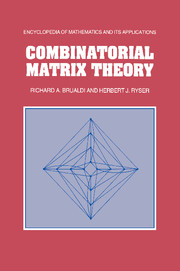Preface
Published online by Cambridge University Press: 05 May 2013
Summary
It was on March 20, 1984, that I wrote to Herb Ryser and proposed that we write together a book on the subject of combinatorial matrix theory. He wrote back nine days later that “I am greatly intrigued by the idea of writing a joint book with you on combinatorial matrix theory. … Ideally, such a book would contain lots of information but not be cluttered with detail. Above all it should reveal the great power and beauty of matrix theory in combinatorial settings. … I do believe that we could come up with a really exciting and elegant book that could have a great deal of impact. Let me say once again that at this time I am greatly intrigued by the whole idea.” We met that summer at the small Combinatorial Matrix Theory Workshop held in Opinicon (Ontario, Canada) and had some discussions about what might go into the book, its style, a timetable for completing it, and so forth. In the next year we discussed our ideas somewhat more and exchanged some preliminary material for the book. We also made plans for me to come out to Caltech in January, 1986, for six months in order that we could really work on the book. Those were exciting days filled with enthusiasm and great anticipation.
Herb Ryser died on July 12, 1985. His death was a big loss for me. Strange as it may sound, I was angry. Angry because Herb was greatly looking forward to his imminent retirement from Caltech and to our working together on the book. In spite of his death and as previously arranged, I went to Caltech in January of 1986 and did some work on the book, writing preliminary versions of what are now Chapters 1, 2, 3, 4, 5 and 6. As I have been writing these last couple of years, it has become clear that the book we had envisioned, a book of about 300 pages covering the basic results and methods of combinatorial matrix theory, was not realistic.
Information
- Type
- Chapter
- Information
- Combinatorial Matrix Theory , pp. vii - xPublisher: Cambridge University PressPrint publication year: 1991
